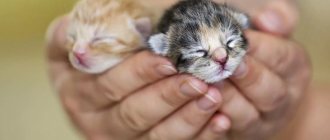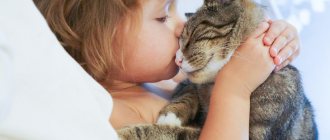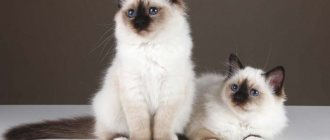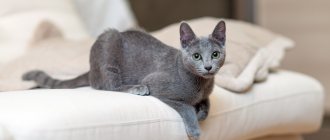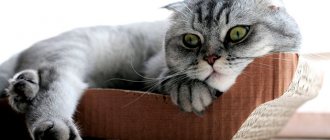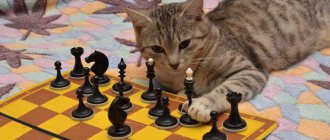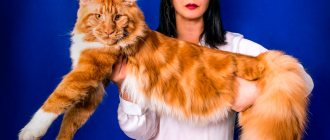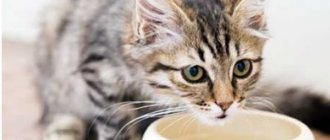Cats are much more adapted to living in an apartment than dogs. And yet, we can highlight several character traits of the animal that will make the cat simply an ideal pet for keeping in an apartment. For example, an ideal apartment cat should be calm, in some cases it may even be passive and be able to occupy itself in the absence of its owners.
You need to remember that, unlike dogs, cats prefer vertical space, so your pet will feel very comfortable if you equip it with a certain number of shelves, stands and niches. And the higher they are, the more comfortable your furry pet will be.
The list below describes the cat breeds that are best suited for apartment living.
Which kitten is better to have in an apartment?
Choosing a kitten for your home is not so easy.
Take into account your preferences and desired character traits. A representative of a passive breed is not suitable for a family with children or for a person who is active by nature. An overly active pet will be difficult to keep in an apartment. Cats shed periodically, and this fact is also taken into account if there are health problems. We recommend paying attention to the following cat breeds:
- Domestic cats of the Scottish breed are sensitive to the mood of the owner and do not require much attention. They are ready to play and are joyfully greeted from work, but do not bother if the owner is not in the mood.
- A Burmese kitten is suitable for those who are ready to pay attention to their growing pet. The Burmese has an easygoing disposition, he is affectionate and gentle, and does not require much space to keep.
- The British Shorthair looks like a plush toy and evokes sympathy and affection. The kitten easily adapts to being kept in an apartment, but does not accept very annoying household members.
- The Russian Blue cat impresses with its friendly character and calmness. Does not require excessive attention, we train well.
- For older people, a Javanese cat is suitable. She is affectionate, playful and responsive to her master's requests.
Main selection criteria
When making a choice, start from your capabilities and preferences. To do this, you will need to take into account the size of your living space, your lifestyle and amount of free time, as well as preferences regarding the appearance and behavior of your future pet.
Residence and area
For a small apartment, a medium or small cat with a calm character is suitable. Large representatives with a developed hunting instinct and an awl in the butt will feel uncomfortable in it - they will be more comfortable in a private house with a fenced area.
The character of the future owner and the whole family
Lonely people in need of communication should take a closer look at talkative cats. Such pets become strongly attached to their owners and help with household chores with great enthusiasm.
It is recommended to take into account your activity. If you like frequent walks and trips out of town, then pay attention to playful breeds that quickly get used to wearing a harness.
Don't forget about other family members. If an extrovert who loves noisy parties lives with you, then the future pet should be distinguished not only by its friendliness, but also by its lack of fear of strangers. Otherwise, constant fear from loud sounds and unusual smells will negatively affect his psyche.
Length of stay of the owners of the house
Your work schedule also plays a significant role. If you often stay late at work and go on business trips, take a closer look at animals that tolerate loneliness well. Otherwise, a pet left for a long time may fall into deep depression or create a mess as a sign of revenge for inattention.
Self-sufficient cats who know what to do with themselves are suitable for workaholics. They don't need to communicate 24/7 and won't bother you if you're not in the mood. Despite their independent character, these “mustaches” are also partial to affection and love to sit in your arms.
The solution for cat lovers is to have two or more pets. They won't be bored much together.
Having small children
Not all children know how to handle animals, and some, due to their age, are not yet capable of learning. For this reason, for children under 3 years of age who cannot control their emotions, it is better to choose a patient and friendly “mustache.”
Such a cat will not only tolerate all pranks, but will also support any children's fun. If your child does cross the line, instead of being hit with a clawed paw, he will simply temporarily lose his playmate.
Presence of other pets
Friendly cats get along well not only with children, but also with other pets. Particular caution should be exercised only by owners of birds, rodents and aquarium fish. Make sure your pet has a weak hunting instinct. Otherwise, the fish birds may become prey.
Pet gender
Having decided on the breed, it is logical to move on to choosing the sex. Each has its pros and cons, so analyze which ones are more important to you.
Females are distinguished by greater cleanliness, docileness and friendliness. They only cause problems during estrus and pregnancy. In the first case, you will have sleepless nights due to loud screams and periodic attempts to escape, and in the second, you will have to find owners for newborn kittens. If there are no plans for breeding, everything can be easily solved with the help of sterilization.
Males are more dominant. They rarely accept affection against their will and often show aggression if something does not go according to their plan. They are also characterized by marking their territory, accompanied by a rather pungent and unpleasant odor. As in females, this problem can also be solved surgically. The advantages of males include attachment to the house and rapid toilet training.
Please note that gender differences are very arbitrary. There are always exceptions to the rules, so this point should be considered only as an additional one. Unusually affectionate cats and extremely aggressive cats are far from uncommon, but the nuances regarding puberty are always static.
Requirements for the coat and color of the pet
The difficulty of grooming directly depends on the length and thickness of the coat. Long-haired individuals with a thick undercoat shed very heavily. Without regular brushing, their fur becomes tangled and can lead to dermatitis.
Completely hairless cats are not so easy either. They sweat a lot and are constantly cold. Because of this, they need to be bathed frequently and dressed in warm clothing.
When choosing the type of coat, proceed from the amount of free time and desire to engage in grooming procedures, and when choosing a color, simply be guided by your ideas of beauty.
You may have heard that white colors are less allergenic, but in fact this opinion has not yet been confirmed by felinologists. For this reason, if you have allergies, it is better to take into account more reliable factors.
The most unpretentious cats for an apartment
The category of unpretentious pets is usually classified as moderately active, independent, and not requiring special care:
- Burmese cats are distinguished by their elegant appearance and easy-going character. They are easy to care for and obedient.
- The Ragdoll is obedient and affectionate, allowing itself to be stroked. The cat’s disposition fully reflects the name of the breed (“rag doll” translated into Russian), and is suitable for keeping in a family with children.
- Representatives of the American Shorthair breed are endowed with a light character. They get along well with other animals and are in good health.
- Burmillas are short-haired, fluffy cats that are very calm and friendly. They get along easily with people and other four-legged household members.
- The Cornish Rex just needs to be fed, trained and petted to your heart's content.
Cat or cat - who is better?
You need to decide on the gender first, since the behavior of females and males is different, and their care is somewhat different. It is generally accepted that cats are more disciplined, affectionate, calm, compliant, and physically active. Cats are lazy, proud, silent, selfish, sedentary. You should not rely on general stereotypes, since each animal is individual, but some factors need to be taken into account.
- Cats are larger and have a stronger smell. With proper care, no unpleasant odor is felt, so there is not much difference.
- Cats try to take a dominant position, so you need to immediately show who is boss in the house and who you have to listen to. Cats are manipulators. They obtain the fulfillment of desires without open confrontation with household members.
- Before puberty, there are no differences in behavior between kittens. During heat, the cat expresses its needs too loudly, meows all day and night, cats intensively mark their territory, become aggressive, and are able to run away from the house.
- Cats are more active, cats are difficult to stir up. If an animal is bred to fight mice, a cat is better suited.
Considering the fact that cats are brought in as living toys and are sterilized, there is not much difference in care, and problems, in general, do not arise. Therefore, the choice depends solely on the preferences of the owner.
Calm cat breeds in the apartment
Breeders try to choose a calmer breed of cat for an apartment in order to save themselves from problems.
Take a closer look at these calm cat breeds:
- The Neva Masquerade breed attracts with its gentle disposition, goodwill and moderate activity. The cat loves communicating with people and understands them perfectly.
- Siberian cat. Representatives of this breed have a calm, friendly character and get used to those who feed them. The pet needs to be combed periodically to prevent tangles from forming in the long fur.
- The exotic has a calm disposition and is very trusting of its owner, loves to cuddle and play, but prefers to hide from strangers.
- The Singaporean breed is quite rare. Such a cat will get along with everyone and will surprise everyone with mutual understanding.
- Persian cats are calm and intelligent. The pet develops a devoted attachment to its owner, for which Persians are known as monogamous people. A cat's fluffy fur requires special care.
Is it worth adopting a purebred cat?
Some people prefer "mutts". These cats did not have noble ancestors in their family or they have mixed roots. And this has its advantages. For example, mestizos have better health than their “blue-blooded” counterparts. This is due to the wider gene pool. Therefore, the risk of genetic diseases is very low.
However, such cats often have an independent character, and their hunting instincts are more pronounced. Adults love to mark territory, and it is not very easy to wean them from this habit.
The “mongrel” has better health
At the same time, purebred cats have predictable habits. They value cleanliness more because breeders select for breeding those individuals that are less prone to marking territory.
Smooth-haired cat breeds for home use
To keep a cat in an apartment with less hair, choose smooth-haired representatives:
- The Balinese cat will be liked by its warm color and silky thick coat without undercoat. Balinese are smart, flexible and obedient.
- A Bengal cat looks like a small leopard. The pet is active, but meek and obedient. Loves games and walks.
- The Devon Rex has fur that resembles astrakhan fur. He loves to spend time lying quietly in his owner's arms and loves being stroked.
- The Bombay cat is nicknamed the charming little panther. Behind the predatory appearance lies an easy-going, unobtrusive nature. She is no stranger to games and “conversations” with her owner.
- The European Shorthair (Celtic) breed is naturally healthy. At home, the Celt remains independent, but is responsive to the owner's affection.
The smartest cat breed in the house
Many purebred cats have a well-developed understanding with humans.
You will find an almost ideal intellectual cat among the following suggested options:
- Siamese cats are inquisitive and smart. The Siamese is sensitive to changes in the owner’s mood, is easy to train, and is able to express a wide range of emotions with sounds and intonation.
- The Canadian Sphynx is able to understand the emotional component of human speech. This pet is friendly to all household members and is able to make friends with other cats and dogs. Loves to play and is trainable.
- The Turkish Angora is a long-haired white cat. He understands his owner well and becomes very attached to him, amenable to training. The Angora is an excellent companion for a lonely person.
- The Oriental cat is endowed with the mental ability to subtly and clearly capture a person’s mood, feel his malaise, and relieve pain with the warmth of his body. Oriental is playful and talkative.
- British cat. The British cat is emotionally restrained, calm and well trained. He can be taught to open the door and turn on the light.
The cleanest cats for indoors
For home keeping, not only the agreeableness of character is important, but also the cleanliness of the pet:
- The Russian Blue cat is carefully groomed, its fur is smooth and clean. A pet accustomed to water will not refuse to bathe.
- The Cornish Rex is a very low shedding breed. The pet's fur feels like velor to the touch.
- Rarely shedding options include the Oriental breed. In addition, the cat does not rush around the apartment.
- The Scottish Fold cat has short and very soft fur. Smart, clean and affectionate.
- The Scottish Fold looks like a Scot. The coat is short and licks well. You can get used to water procedures.
Potential difficulties of living with a cat
1. Cats go to the toilet . Yes, and “in a big way” too. Of course, cats are much more clean than dogs; they cannot go to the toilet due to carelessness or from excess emotions, but cats also happen to shit in the wrong place. There can be many reasons for this, but in this case the point is different - the area of the apartment is small, and the smell of cat excrement is quite pungent. This can cause problems with neighbors or homeowners. Therefore, it is preferable to choose animals that are already tray-trained.
Cat litter and kitten
If you think that cats are easy to train and their instincts themselves will push them in the right direction, you are mistaken. Our editor is the proud owner of two large mongrel cats, one of whom completely refuses to remember that a trash can is the wrong place for his litter box. And even if it is possible to convince him of this today, it is not a fact that tomorrow the situation with the surprise found in the trash bin will not repeat itself.
2. Cats shed . And this is also a problem. Are you ready for your entire apartment to be strewn with cat hair? It will get everywhere: on clothes, in food, on all surfaces. In a small space, especially during periods of seasonal molting, cat hair turns into a real punishment.
Grooming a long-haired white cat
Moreover, some cats periodically develop dandruff, to which you or your family members may be allergic. So, when choosing an animal, you need to remember about the upcoming “war” with its fur, and if this is a problem for you, it is better to choose smooth-haired breeds or sphinxes in general. On the other hand, with proper care, problems with the coat will practically not arise. In any case, it is worth paying attention to this issue.
3. Cat's temperament or character . In some cases, it can also present very unpleasant surprises. If you live in a relatively small apartment, you should choose a furry friend of a breed that has the following characteristics:
- lack of a pronounced instinct for one’s own territory;
- easy perception of loneliness;
- sociability;
- friendliness towards strangers;
- not too high activity.
Interesting: Why does a cat lick a person?
The last thing is worth explaining - cats with high activity require a lot of space for their games. They physically need to spend their energy somewhere, so they rush around the apartment like mad, turning over various objects, damaging furniture, knocking you off your feet. Such animals need to be in the fresh air, so keeping them in an apartment will be problematic for you.
The most hypoallergenic cats in the apartment
People suffering from allergies should choose a cat with caution.
The following breeds are suitable for allergy sufferers:
- The Oriental Shorthair cat practically does not shed, and its excreta contains minimal amounts of the animal allergy-causing protein Fel D1.
- Cornish Rex. It also rarely causes problems with portability.
- The Javanese breed is bred artificially. The Javanese has a fine, silky coat without undercoat. Due to these qualities, it is classified as a hypoallergenic cat.
- The secretions of the Siberian cat are hypoallergenic. The character of the representative of this breed is flexible, the cat is not annoying and does not get underfoot.
- The Ocicat has short hair that rarely sheds. Follows simple commands and can be trained to walk on a leash.
Popular hairless cat breeds
List of unusual hairless cats:
- Petersburg Sphinx. This is a green-eyed or blue-eyed cat with a muscular body, proud posture and a long neck. The body of the Peterbald is covered with a soft, suede-like undercoat and 2 mm of hair.
- The Kohana is a cat breed native to Hawaii. A cat's skin resembles a soft, waxy surface and is completely lint-free.
- The Don Sphynx is a hairless cat with an almond-shaped, trusting gaze and extravagant ears. He is distinguished by his flexible character.
- The Canadian Sphynx is characterized by an abundance of folds on its graceful, hairless body. The cat surprises with its huge eyes, reflecting the blue of the sky, and is distinguished by its friendliness and sociability.
- The Bambino is a relatively new breed. Characteristic features are a smooth, hairless body with short legs, large ears and a long narrow tail. The cat's character is good-natured and sociable.
The smallest cat breeds
We present to the attention of lovers of small-sized cats the following dwarf breeds:
- Skif-tay-don is a dwarf breed. An adult cat weighs no more than 1.5 kilograms. The pet has beautiful light-colored fur with black accents on its face, ears, paws and the tip of its tail, and its disposition is playful and inquisitive.
- The Munchkin is a fidget on short legs, with a build similar to a dachshund. Loves to make hiding places with his favorite toys. A cat of this breed weighs no more than 3.5 kilograms.
- Napoleon is a small cat with luxurious thick fur on short legs. Attracts with expressive, captivating eyes. The weight of a cat rarely reaches 4 kg.
- The Lamkin is a breed of small cat with a curly and fluffy coat. The name in Russian translation means “lamb”.
- Kinkaloo belongs to the weight category of 2-3 kilograms. The cat is active and playful, loves walks with her owner.
Scottish Fold breed
A young breed dating back to the 20th century. A distinctive feature of the breed is the hanging ears, which give the round muzzle of the Scottish Fold even greater roundness. Interestingly, kittens of this breed are initially born with straight ears, which then begin to fold. They reach their final appearance at about 12 weeks. The Scottish Fold is a very hardy breed and adapts well to any conditions. Usually, they choose only one of the family members as their owner, but they also behave very friendly with other family members, be it a person or another pet.
Representatives of the breed are moderately active, intelligent and love games in which they can use their intellectual abilities. But most of all he enjoys communicating with people. He tries to take part in all matters that the family is involved in.
Lifespan: 11-14 years.
Weight and size: height - 20-25 cm, cat weight - 3-5 kg, cat weight - 2.5-3.5 kg.
Grooming: Grooming depends on the length of the coat. Long-haired representatives of the breed should be brushed more often to avoid the appearance of tangles. Particular attention should be paid to ear cleaning, which should be taught from early childhood. You should also have your pet's ears checked periodically by a veterinarian for parasites and infections. To prevent excess weight gain, you need to follow a diet and not overfeed your pet. You should handle the Scots tail with caution: do not pull it under any circumstances. If you notice that your cat is in pain when moving its tail, it is best to ask your veterinarian to check whether your cat has arthritis. Unfortunately, joint diseases in this breed are genetic.
The fluffiest cats for an apartment
The following furry pets are suitable for keeping in an apartment:
- Angora is a graceful cat with a peaceful disposition.
- Ragamuffin is the owner of a surprisingly luxurious fur coat that requires special care. The cat needs to be bathed and brushed.
- The Persian cat is fluffy and imposing. Requires care.
- The Siberian cat is beautiful and proud of its luxurious tail. The fur is moderately fluffy and does not tangle too much.
- The fur coat of a Kimra cat is comparable to that of a rabbit to the touch. The cat is not a timid cat and is capable of protecting its owner.
The most original cats for home
If you want to have a pet with an unusual appearance, check out these options:
- The Minskin cat looks like a hobbit. Thick and dense hair covers certain areas of the cat's naked body - the head, ears, paws and tail.
- Dwelf looks like an alien from another planet. A small head with large eyes and ears curved inward, a long, squat body, devoid of hair.
- Mei-kun is a giant among cat breeds. He is good-natured, endowed with soft fluffy hair and cute tassels on his ears.
- The Savannah cat has a leopard coloration. She is large in size, with a good-natured character. Willingly keeps the owner company on a walk.
- The Japanese Bobtail is a cat with an unusual, rabbit-like tail. He is active and intelligent, receptive to training.
Cat breeds with good character
The excellent character of a four-legged pet is expressed in such qualities as friendliness and obedience.
A list of cats with wonderful personalities is presented below:
- The Abyssinian cat is distinguished by its balanced disposition and loyalty. She is always ready to give and receive attention.
- Toyger is a medium-sized tabby cat. He has a non-conflict character and gets along easily with his family.
- The Bengal cat not only looks attractive. He has a developed intelligence and a friendly disposition.
- Sacred Burmese cats are obedient and get along well with children and guests.
- Smart and calm Burmese cats are wonderful walking companions and are happy to follow their owner’s commands.
Sphinx
Photo Credit: my destination's beautiful Flickr via Compfight
Despite the fact that the Sphynx breed is quite ancient, modern Sphynxes appeared only in the 20th century. Initially, the breed was not specially bred, and appeared as a result of a natural mutation, but then breeders began to make attempts to repeat the birth of hairless kittens. Since then, the Sphynx breed has become increasingly popular. One thing is obvious: there is no such person who would remain indifferent to him. Anyone who sees the Sphinx begins to feel either incredible sympathy or complete rejection.
Sphynx cats are very active, inquisitive, intelligent and get along well with other pets. The Sphinx's favorite place to stay is the lap of its owner. But he will not impose himself on you if you are not in the mood to communicate with him.
Lifespan: 10 -15 years.
Weight and size: height - 20-25 cm, cat weight - 4-5 kg, cat weight - 3-4 kg.
Care: In terms of care, the Sphynx will require more attention from you than any other breed. It is necessary to bathe your Sphynx every week, otherwise he will start to smell unpleasant and leave greasy marks on the furniture and your clothes. Between baths, you can wipe your Sphynx with wet wipes. In the summer, the Sphynx needs to be protected from sunburn, and in the winter, you will have to wrap it in cat sweaters and overalls. The eyes and ears of sphinxes will also require special attention. They must be wiped once a week with damp cotton pads.


